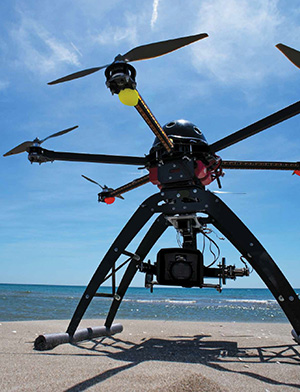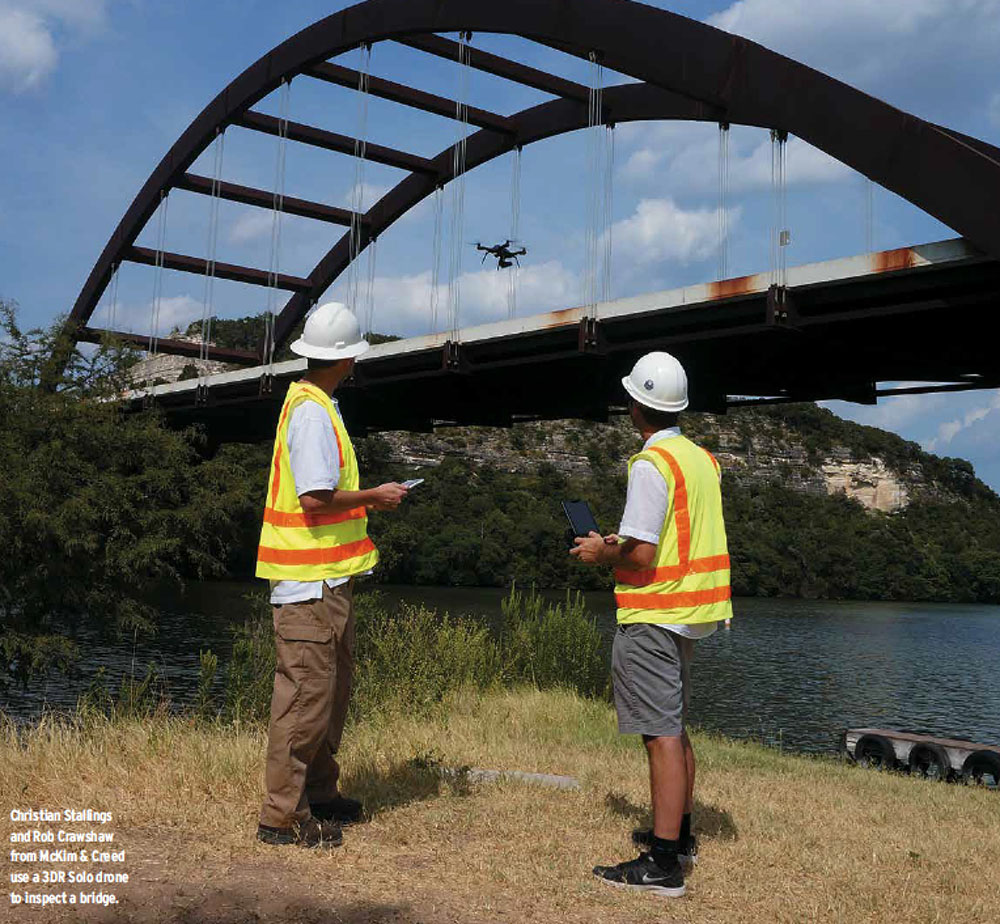AMERICAN COUNCIL OF ENGINEERING COMPANIES
Unmanned aerial vehicles will change the way engineers work—if regulations can catch up to the technology
-By Bob Violino
 Unmanned aerial vehicles (UAV) or unmanned aircraft systems (UAS), commonly known as drones, are beginning to generate unique opportunities for the engineering sector. Though developed in the 1970s for the military, commercial use has lagged behind because of cost, regulations and specialized skills required to operate. But that is quickly changing.
Unmanned aerial vehicles (UAV) or unmanned aircraft systems (UAS), commonly known as drones, are beginning to generate unique opportunities for the engineering sector. Though developed in the 1970s for the military, commercial use has lagged behind because of cost, regulations and specialized skills required to operate. But that is quickly changing.
In recent years, prices have dropped, key component parts such as batteries have improved, and software has advanced, all resulting in many new commercial and construction applications.
The only obstacles prohibiting more rapid utilization are the uncertain regulations governing commercial use of drones.
“UAS technology has advanced much faster than the regulatory framework,” says Brian Wynne, president and CEO of the Association for Unmanned Vehicle Systems International (AUVSI), a nonprofit organization devoted to advancing unmanned systems. “Many businesses want to use UAS but remain grounded until the rules are in place.”
The Federal Aviation Administration (FAA) has published draft regulations for small UAVs that fly within an operator’s line of sight, and the agency is currently reviewing comments. Orrin (Mac) MacMurray, former ACEC chairman and now chairman emeritus of consulting firm C&S Companies, is representing the Council on an FAA rulemaking committee that is advising the FAA in its efforts to safely integrate drones into national airspace.
“Currently, use of UAVs is limited to hobbyists,” MacMurray says, “unless the FAA issues what is known as a Section 333 exemption.” Firms that want to use drone technology for a specific commercial purpose need to apply for and obtain such an exemption.
Final regulations on small UAVs will follow the review period, but the timing is unknown, MacMurray says. “It is expected that engineers will be allowed to use small UAVs for commercial use up to 500 feet above ground level without an exemption.”
This will allow some engineering tasks to be done, such as flyover roof inspections of buildings under 500 feet, MacMurray says. “However, this will not allow many of the uses requiring altitude or flights beyond visual line of sight,” he says.
A second rulemaking process has begun to address the use of drones beyond visual line of sight, and the committee on which MacMurray serves has met several times with the FAA. But no date has been set for draft regulations “Beyond visual line of sight is where the real high-value use of [drones] really is for many industries, including engineering,” MacMurray says. “It is here, for example, where one could program a UAV to fly with a heat sensor down a power line and check for hot spots without having to visually see the UAV.”
Drones in the Field
The uncertain operational environment of drones makes investing in the technology a risky prospect for firms.
But that ambiguity hasn’t discouraged several engineering firms from starting to use drones. The FAA has approved nearly 1,500 Section 333 exemptions to date, and requests are far outpacing approvals. “So there is clearly a growing appetite for UAS technology,” Wynne says.
Woolpert was one of the first engineering firms in the nation to receive a Section 333 waiver and has since focused on UAS testing, product development and data integration, says Layton Hobbs, vice president and director of technology and development at Woolpert.
The firm is focused on how drones will benefit its core service offerings, including engineering and geospatial technologies. “We’ve completed several mapping and imaging-related projects this year using UAS,” Hobbs says.
Woolpert clients are interested in the use of drones for construction site monitoring in support of the company’s traditional construction inspection services.
“Fundamentally, the benefit of UAS is its ability to attain and record a broad perspective of features, movements or changes on the ground,” Hobbs says.
The use of drones will supplement these capabilities by allowing a small team to deploy a mapping or imaging system over much smaller sites than were economically feasible in the past, Hobbs says. “And because we can revisit the site daily or even hourly, we can track change at a level not possible with traditional manned systems—for example, when monitoring a major phase of building or site construction,” he says.
The industry “has always adapted or even led in the development of ‘measurement’ technology for its business cases,” Hobbs says. “GPS, laser range finders, remote camera and CCTV systems, roadway scanners, chemical and flow monitors—these are all examples of high-tech systems we use every day in our work. UAS will, eventually, be just another tool in the toolbox.”
Unlimited Potential
Christian Stallings, a certified photogrammetrist at McKim & Creed, says his firm has received FAA approval to fly three different UAV models. The firm plans to have a team travel from project to project throughout its service areas, with licensed pilots operating the systems.
“Once the FAA creates a written exam for small UAVs, we plan to train our survey teams and have an internal training and safety program so that it becomes a standard service and tool for each survey team,” Stallings says. Potential uses for these systems include infrastructure inspections and creating 3D elevation information for landfills, quarries and other small sites.
“We find that potential applications from this tool complement many of our existing services and in many cases provide a more cost-effective way to provide products,” Stallings says. “For example, surveying stockpiles using traditional survey or terrestrial scanners used to take a few days, but now we find that we can create the same products in a day and hope to speed that up even more utilizing near real-time cloud processing in the future.”
McKim & Creed plans to add more drones in the future and is evaluating whether it makes more sense to do all of its own acquisitions or to contract with other firms. “Ideally, we want to create value-added products that meet our clients’ needs in a timely manner at the highest quality,” Stallings says. “What makes the most sense to achieve that goal today may not be true tomorrow.”
The great thing about the technology “is that it’s a means to get some type of sensor payload in the air, ground or water to collect information,” Stallings says.
Engineering and construction companies will use these vehicles for surveying, taking aerial photos of sites and performing inspections of all types. MacMurray says, “Imagine being able to inspect a bridge without lane closures or fly along the route of a buried gas line sensing for leaks. If you can think of it, this technology will affect it in some way.”
There are many other promising applications for the technology, MacMurray says. “Uses are limited only by one’s imagination and the development of the technology itself.”
Download full article (PDF): Industry Drone Use Taking Flight
 About the American Council of Engineering Companies
About the American Council of Engineering Companies
www.acec.org
The American Council of Engineering Companies (ACEC) is the voice of America’s engineering industry. Council members – numbering more than 5,000 firms representing more than 500,000 employees throughout the country – are engaged in a wide range of engineering works that propel the nation’s economy, and enhance and safeguard America’s quality of life. These works allow Americans to drink clean water, enjoy a healthy life, take advantage of new technologies, and travel safely and efficiently. The Council’s mission is to contribute to America’s prosperity and welfare by advancing the business interests of member firms.
Tags: ACEC, American Council of Engineering Companies, Drones, Engineering Inc., Inspection, UAS, Unmanned Vehicle Systems







 RSS Feed
RSS Feed